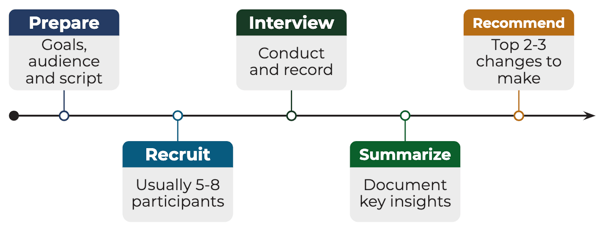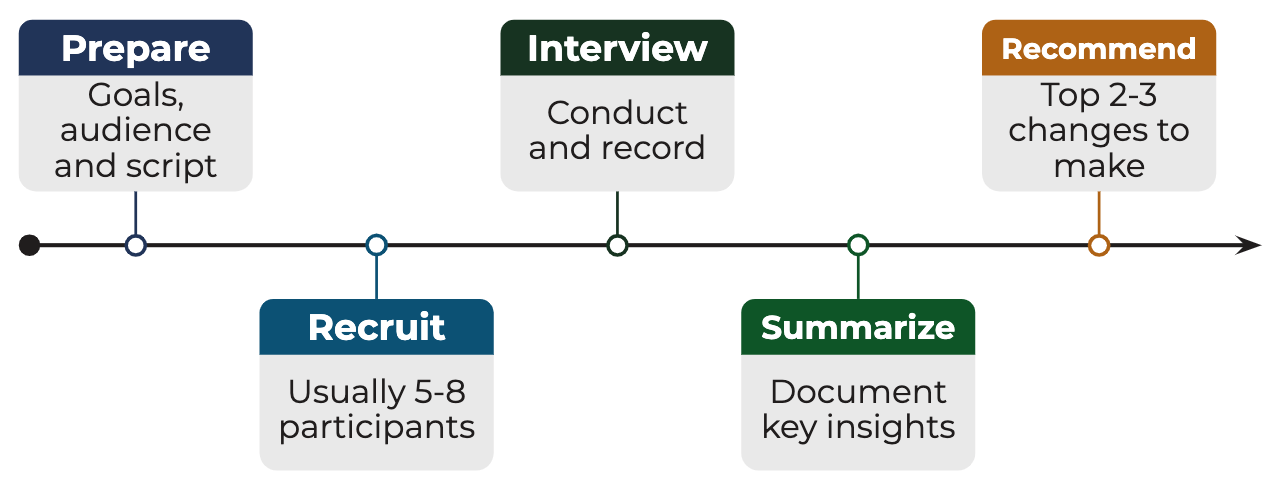One of the most common consulting engagements we do is market research interviews, and it usually comes up in when a company is:
- Trying to decide whether to launch a new product or feature
- Conducting usability testing on a new product or feature
- Collecting competitive intelligence to inform their strategic plan
Having done hundreds of market / customer research interviews, we've boiled the process down to 5 steps:

Let's look at them in greater detail.
Prepare
During this step, you're documenting the goals of the study and the target audience, and from those, deciding on the right format for the interviews (ex. remote, in-person, etc) and the interview guide. A couple of best practices for this step:
- Document the team's hypotheses. It's really helpful to get down what everyone thinks they'll learn from this study. Why? To highlight the amount of learning market research can provide - I'm always amazed at how often internal assumptions are wrong.
- Start broad and get specific. As you structure your interview guide, think about the flow of the conversation. I usually allocate time to start with some warm up questions / small talk to get the person comfortable talking, then kick off with something like "what are the top 2-3 things that keep you up at night?" to get a sense for what challenges are top-of-mind for them. Why? I want to know whether the product addresses those top-of-mind challenges, not something 15 items down on their list of worries in life.
Recruit
Next you need to recruit the target audience and schedule interviews. Typically interviews last 30 - 60 minutes, but that all depends on how many questions you have in your interview guide. A couple of best practices here:
- Use a recruiting service. I'm a huge fan of User Interviews as I've been able to schedule 5-6 interviews in about 30 minutes with high-quality participants. If you like, you can use Prodify's referral link to sign up - I use the free credits for Prodify market research or give them to clients to show how valuable market research is.
- Screen properly. There are a lot of "professional respondents" who make a lot of money from market research interviews. To screen them out, make sure the "right" answer isn't obvious in your screening questions. For example, instead of asking "When was the last time you used a recipe app?", ask "Which of the following app have you used in the past 2 months?" and include recipe apps in the checkbox list.
Interview
Now the part that takes the most practice - interviewing the participants. A couple of tips here:
- Keep it conversational. You don't want the interview to feel like the nurse who takes your vitals and asks a list of questions from her checklist. You want it to feel like a conversation that you're leading based loosely (but not strictly) on your interview guide.
- Avoid leading questions. Ask open-ended questions and be very careful about the assumptions you're making. For example, ask "Could you tell me what you like about our product so far?" instead of "So you find our product useful, right?". If it's helpful, write out the specific wording of the questions in your interview guide to avoid bias.
Summarize
Once you've interviewed the participants, you'll want to summarize some of the key takeaways from the interviews for your stakeholders. A couple of tips here:
- Jot down insights right after each interview. I've found it helpful to give myself 15 minutes between interviews to jot down any key insights I took away from the interview. If you're interviewing with other people, do this as a group. "What was surprising or interesting about that interview?" is a good question to ask.
- Listen to recordings if possible. I typically record every interview so I can go back to listen for key insights after the fact. It's easy to miss interesting nuggets if you're leading the interview rather than just observing.
Recommend
Finally, make 2-3 recommendations on what you think the team should change about the product or overall customer journey as a result of the interviews. A couple of best practices as you do this:
- Connect the recommendations to the summary. Don't make recommendations that are disconnected from the key insights you highlighted in the summary. If it's helpful, create a table that highlights the key insights and puts 1-2 recommendations right next to each insight.
- Prioritize. Don't list every tweak that needs to be made - choose the hard-hitting top 2-3 that would really move the needle for the product.
Closing Thoughts
One of the biggest mistakes we see teams making is not conducting enough market research to get qualitative feedback on their vision, strategic plan and today's customer journey. It's not enough to analyze customer product usage data - you need these qualitative interviews to better understand your customers' lives and why they behave the way they do. This is why we focus on this part of the feedback loop so much when we help teams optimize their execution.
Note: this post is an excerpt from a 20-page Google Doc we have in The Library. The document clients have access to also includes more tips for each step, example artifacts for every step and a few great articles on market research. For information on becoming a Prodify client and gaining access to all of The Library, please contact us.

